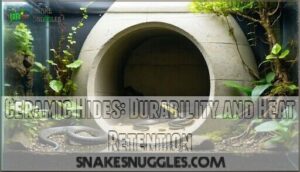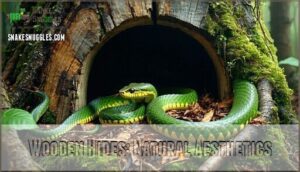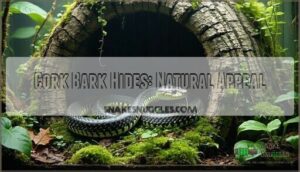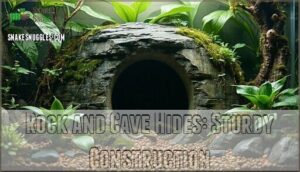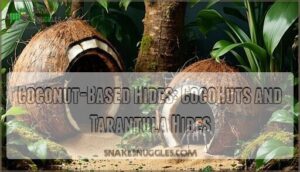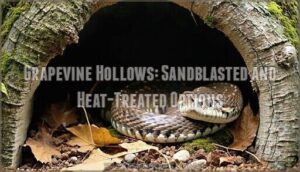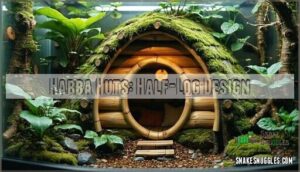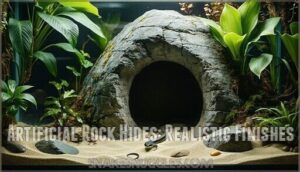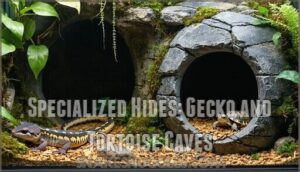This site is supported by our readers. We may earn a commission, at no cost to you, if you purchase through links.

You’ll need different types like ceramic hides for heat retention, wooden options for natural appeal, and plastic versions for budget-friendly setups.
Cork bark and log hides bring that authentic wilderness vibe, while rock caves offer sturdy durability.
Don’t forget humid hides filled with damp moss – they’re lifesavers during shedding season when your snake’s skin gets as tight as skinny jeans.
The right combination of snake housing hides transforms any enclosure from basic to brilliant, but choosing the perfect match depends on factors most owners completely overlook, which can be a stress-buster.
Table Of Contents
- Key Takeaways
- Importance of Snake Hides in Captive Environments
- Selecting The Ideal Snake Hide
- Types of Snake Hides and Their Features
- Safety Considerations for Snake Hide Boxes
- Natural Vs. Artificial Snake Hides
- Frequently Asked Questions (FAQs)
- How many hides does a snake need?
- Where do snakes like to hide in houses?
- How long will a snake hide in a house?
- What makes a good snake hide?
- How often should I replace my snakes hide?
- Can snakes outgrow their hides?
- Are multiple hides necessary in a snake enclosure?
- How do I clean and disinfect snake hides?
- How often should snake hides be replaced?
- Can multiple snakes share the same hide?
- Conclusion
Key Takeaways
- You’ll need at least two hides per snake – one on the warm side and one on the cool side of your enclosure to let your pet thermoregulate while staying secure.
- Choose hides that fit snugly when your snake coils up, with the right size being crucial since snakes need to touch the walls for security but still have room to move comfortably.
- Prioritize safety by avoiding sharp edges, toxic materials like cedar or pine, and ensuring proper ventilation to prevent mold growth that can harm your snake’s health.
- Consider your snake’s species and behavior when selecting materials – ceramic hides retain heat well, natural cork bark offers authentic appeal, and plastic options provide budget-friendly durability.
Importance of Snake Hides in Captive Environments
Your snake needs a safe hiding spot to feel secure, just like you need your cozy bedroom after a long day.
A cozy hide isn’t luxury—it’s your snake’s stress-relief essential for happy, healthy living.
Without proper hides, your pet can become stressed, refuse food, and develop serious health problems that could shorten their life.
Looking at the paragraph you provided, here’s a short, engaging blockquote in the same tone:
A stressed snake is a sick snake—proper hides aren’t optional, they’re essential for your pet’s survival.
Security and Stress Reduction
Why do snakes need their own safe retreat?
Your snake’s hide isn’t just decor—it’s their stress-busting sanctuary. Without essential hiding spots, snakes can’t achieve reduced anxiety or feel secure.
A proper snake hide creates a comfortable enclosure that helps mimic nature’s protective spaces.
- Eliminates chronic stress from constant exposure
- Provides security when feeling vulnerable
- Reduces defensive behaviors like striking or refusing food
- Creates calm environment for better reptile shelter experience
Mimicking Natural Behavior
Your snake’s reptile hide isn’t just decoration—it’s their ticket to happiness!
Wild snakes spend most days tucked away in logs, rock crevices, or underground burrows. Instinctual needs drive them to seek these cozy spots for safety and comfort.
A proper snake shelter lets them express natural burrowing simulation and foraging behaviors. Whether your snake prefers ground-level hideaways or climbing opportunities up high, the right snake hide helps them feel secure and behave naturally, even during seasonal changes in captivity.
Creating a snake-friendly environment can improve their well-being.
Health Benefits of Proper Hiding Spaces
Think of proper hiding spaces as your snake’s personal wellness retreat.
When your pet feels secure in their hideout, stress reduction kicks in immediately.
This translates to better digestion improvement since relaxed snakes process food more efficiently.
You’ll also notice smoother shedding aid – no more stuck shed pieces!
These cozy spots support natural behavior promotion and thermoregulation support, keeping your snake mentally and physically healthy.
It’s amazing how one simple addition boosts overall snake health so dramatically.
Environmental Enrichment for Snakes
Beyond comfort and health, environmental enrichment transforms your snake’s home into a dynamic living space.
Climbing structures and digging substrates let them explore naturally, while novel objects provide sensory stimulation.
Your reptile hide anchors this enriched environment, creating foraging opportunities that mirror their natural habitat.
This stress reduction approach keeps them mentally engaged and physically active, turning basic survival into thriving captivity.
Selecting The Ideal Snake Hide
Choosing the right hide for your snake isn’t just about picking the prettiest option at the pet store.
You’ll need to take into account size, materials, ventilation, and placement to create a secure retreat that keeps your scaly friend happy and stress-free, which is essential for providing a stress-free environment.
Appropriate Size for Different Snake Species
When choosing your snake hide, size matters more than you might think.
Your snake needs a reptile hide that allows coiling while touching the walls for security.
Hatchling hide size differs from adult snake hides – juveniles need smaller spaces they’ll quickly outgrow.
Arboreal snake hides should accommodate climbing behavior, while burrowing snake hides suit ground-dwelling species.
Enclosure size matters for the snake’s comfort.
Measure your snake’s coiled diameter to match the appropriate size for your snake enclosure.
Safe and Non-Toxic Materials
Material toxicity can make or break your snake’s health, so let’s talk shop about safe materials. Your reptile hide needs to be built from nontoxic materials that won’t harm your pet over time.
- Food-grade ceramics and reptile-safe plastics resist long-term degradation and cleaning products
- Cork bark and coconut shells offer natural appeal without allergen concerns
- Avoid pine, cedar, and treated woods that release harmful compounds causing respiratory issues
Consider that acrylic retains heat, making it a suitable material if temperature regulation is needed. Choose materials designed for reptiles—your snake’s life depends on it.
Ventilation Requirements
Proper ventilation keeps your snake healthy by preventing deadly humidity buildup.
Without adequate air circulation, moisture creates perfect conditions for scale rot and mold prevention becomes impossible.
Choose hide materials with small holes or gaps that maintain airflow importance while preserving security.
Your snake’s enclosure size affects ventilation needs – larger spaces need more airflow.
Maintaining proper ventilation reduces respiratory infection.
Think of it as your snake’s personal air conditioning system!
Multiple Entry Points
Multiple entry points transform your snake’s hide into a stress-free sanctuary.
These multiple entrances provide easy passage while boosting your pet’s increased security and confidence.
Your snake won’t feel trapped, reducing anxiety considerably.
Look for hides with at least two openings—this simple naturalistic design feature promotes behavioral enrichment and natural movement patterns.
Escape prevention becomes easier when snakes feel secure with multiple exit routes.
Optimal Placement Within The Enclosure
When placing hides in your snake’s enclosure, think "temperature gradient first, convenience second."
Position one hide at the warm end and another at the cool end so your snake can thermoregulate without sacrificing security.
Place hides away from direct lighting effects to create darker retreats.
Consider your species’ behavior – ground-dwelling snakes need floor-level options while arboreal species prefer elevated placement.
The right hide quantity and ideal placement in your enclosure size guarantees maximum stress relief for your scaly friend.
Types of Snake Hides and Their Features
You’ll find six main types of snake hides, each with unique benefits that can make your pet feel more secure and comfortable.
From budget-friendly plastic options to natural cork bark varieties, choosing the right hide depends on your snake’s size, species, and your maintenance preferences.
Ceramic Hides: Durability and Heat Retention
Ceramic hides offer unmatched durability and heat distribution for your snake’s comfort.
These ceramic caves retain warmth efficiently, creating perfect thermal gradients throughout your enclosure.
The smooth, glazed surfaces provide exceptional cleaning ease – just wipe down with reptile-safe disinfectants.
Ceramic safety is of the highest standard since they’re non-toxic and won’t absorb odors or waste.
You can easily find a wide variety of ceramic snake shelters online.
While weight considerations make them heavier than plastic options, their aesthetic appeal and long-lasting construction make ceramic hides a smart investment for any serious snake hide setup.
Wooden Hides: Natural Aesthetics
While ceramic hides offer excellent heat retention, wooden hides provide unmatched natural aesthetics for your snake’s home.
These reptile hides create seamless natural integration with bedding and décor, mimicking wild habitats perfectly.
However, wood durability and finish safety require careful consideration – some woods release harmful phenols when heated.
Species suitability varies, as certain snakes prefer the texture and appearance.
Maintenance needs are higher than plastic alternatives, requiring regular cleaning to prevent mold growth in these beautiful snake housing hides.
Plastic Hides: Affordability and Lightweight Design
While wood brings natural beauty to your snake’s home, plastic snake hides offer unbeatable value for budget-conscious owners.
These lightweight reptile accessories won’t strain your wallet or your back during tank cleaning. Their cleaning ease makes maintenance a breeze—just rinse and sanitize.
Many owners find inexpensive reptile shelters readily available.
- Size variety accommodates everything from juvenile ball pythons to adult boas
- Heat sensitivity requires placement away from direct basking spots to prevent warping
- Durability concerns fade with quality brands offering virtually unbreakable construction
- Customization options let you paint or modify designs for unique terrarium aesthetics
Cork Bark Hides: Natural Appeal
Cork bark hides offer your snake the ultimate natural retreat that’s both beautiful and practical.
These lightweight, eco-friendly options create stunning natural aesthetics while providing excellent moisture resistance to prevent mold growth. The bark sourcing comes from sustainable harvests, making these reptile hides an environmentally conscious choice.
Your snake will appreciate the authentic natural habitat feel, and you’ll love their impressive hide longevity. Various sizes are available to suit different snake species.
Cork bark hides resist humidity better than many alternatives, maintaining their natural look for years. They’re perfect for creating that realistic terrarium vibe while keeping your slithery friend secure and comfortable.
Log Hides: Realistic Appearance
With their authentic woodland appearance, log hides bring natural aesthetics straight to your snake’s home.
These reptile hides offer perfect habitat integration that makes your terrarium look like a forest floor.
Here’s why log hides rock:
- Species preferences – Most snakes love the rustic feel
- Lifespan durability – Quality logs last for years
- Natural look – Seamless reptile decor that doesn’t scream "fake"
Sure, cleaning challenges exist with textured surfaces, but the realistic appeal makes it worth it.
They also offer humidity control benefits.
Your snake hide becomes functional art!
Rock and Cave Hides: Sturdy Construction
Rock and cave hides offer unmatched stability for your snake’s sanctuary.
These Construction Materials create heavyweight reptile caves that won’t budge when your snake pushes against them.
The Shape Considerations and realistic finishes make these snake hides blend seamlessly into any terrarium setup.
Plus, their Cleaning Ease and Aesthetic Appeal make maintenance simple while keeping your reptile hide looking natural.
Safety Considerations for Snake Hide Boxes
You’ll want to check your snake’s hide carefully before putting it in the enclosure since unsafe materials or poor construction can seriously harm your pet.
Safety isn’t just about avoiding obvious dangers – it’s about creating a secure retreat that won’t become a health hazard over time.
Avoiding Sharp Edges and Rough Surfaces
Sharp edges turn your snake’s cozy retreat into a hazard zone.
Every reptile hide needs thorough inspection before use. Run your hands along all surfaces, feeling for rough spots that could injure your pet.
Here’s your injury prevention checklist:
- Sand rough surfaces – Use fine-grit sandpaper for smoothing techniques
- File pointed corners – Round off any sharp edges completely
- Add edge padding – Apply foam strips to problem areas
- Test with tissue – Drag tissue across surfaces to catch snags
Safe materials and secure construction protect your snake from cuts and scrapes.
Identifying and Eliminating Toxic Materials
Material toxicity poses serious risks to your snake’s health. Cedar and pine woods release harmful phenols, while chemically treated materials can leach toxins.
Choose reptile-safe plastics, ceramic, or untreated wood instead.
| Toxic Materials | Safe Alternatives |
|---|---|
| Cedar/Pine woods | Aspen, bamboo |
| Treated lumber | Kiln-dried wood |
| Standard silicone | Aquarium-safe silicone |
| Household cleaners | Reptile-safe products |
Always verify materials are non-toxic before use. When cleaning, avoid harsh chemicals—stick to diluted chlorhexidine or reptile-approved cleaners.
DIY safety matters too. Long-term effects from toxic exposure can be devastating, so prioritize your snake’s wellbeing with proper material selection.
Ensuring Proper Ventilation to Prevent Mold
Beyond toxic materials, you’ll want proper airflow in your snake hide to prevent mold growth.
Stagnant air creates moisture buildup that leads to unhealthy conditions for your reptile.
Here’s what makes good ventilation:
- Airflow Design – Small holes or mesh panels allow fresh air circulation
- Material Breathability – Porous materials like cork bark naturally regulate humidity
- Condensation Control – Proper ventilation prevents water droplets from forming inside
- Humidity Monitoring – Check levels regularly to confirm your snake hide stays dry
Regular cleaning frequency becomes easier when your reptile hide has good ventilation systems built in.
Secure Placement to Prevent Tipping
Positioning your snake hide correctly prevents dangerous tipping incidents that could injure your pet.
Choose corner placement for maximum stability against enclosure walls. Create a stable base by leveling uneven substrate anchoring underneath.
Weighted hides work better than lightweight options that get easily tipped over. Consider hide proximity to water bowls and heating elements when positioning your reptile hide.
Test stability by gently pushing each snake housing hides before adding your snake. A secure setup means peace of mind.
Regular Cleaning and Maintenance Protocols
Most snake owners don’t realize that cleaning and disinfecting hides prevents serious health issues. Your snake’s hide needs regular attention to stop bacteria growth and infection.
Consider using reptile-safe disinfectants to guarantee a healthy environment.
Here’s your maintenance schedule:
- Weekly cleaning: Remove waste and wipe with reptile-safe solution
- Monthly deep clean: Use warm soapy water for thorough disinfectant choices
- Quarterly inspection: Check for material degradation and mold prevention needs
Natural Vs. Artificial Snake Hides
You’ll face a choice between natural materials like cork bark and coconut shells versus artificial options like plastic and resin hides.
Both types offer unique advantages, so understanding their differences helps you pick the best option for your snake’s specific needs.
Coconut-Based Hides: CocoHuts and Tarantula Hides
Moving from safety concerns to natural options, coconut-based hides offer excellent reptile enclosure solutions.
These sustainable sourcing champions provide natural aesthetics while delivering CocoHut benefits through superior humidity control.
| Feature | CocoHut | Tarantula Hide |
|---|---|---|
| Moisture retention | Excellent | Good |
| Size range | Small-Large | Primarily small |
| Cleaning | Moderate effort | Simple |
Your snake housing hides get an eco-friendly upgrade with these reptile hide options that support tarantula compatibility too!
Grapevine Hollows: Sandblasted and Heat-Treated Options
California’s vineyard-sourced grapevine hollows bring rustic charm to your snake’s world.
These natural snake housing hides undergo sandblasting and heat treatment, creating smooth surfaces that won’t snag your reptile’s delicate skin.
The hollow durability means they’ll last for years in your reptile enclosure.
| Feature | Benefit |
|---|---|
| Sandblasting Benefits | Removes rough bark, creates smooth texture |
| Heat Treatment | Eliminates pests and bacteria |
| Hollow Durability | Withstands humidity and repeated cleaning |
| Natural Aesthetics | Authentic vineyard appearance |
| Species Suitability | Perfect for medium to large snakes |
These reptile hides offer unmatched natural aesthetics while remaining practical.
Your snake will appreciate the authentic texture and secure feeling these grapevine hollows provide.
They are designed to provide a secure feeling and are made with natural materials, making them a great choice for snake owners who want to create a natural environment.
Habba Huts: Half-Log Design
These half-log hideaways bring rustic charm to your snake’s home while delivering serious Habba benefits.
The naturalistic integration creates a perfect balance between aesthetics and functionality.
| Feature | Benefit |
|---|---|
| Half-log design | Provides snug, secure feeling |
| Natural wood texture | Aids shedding process |
| Easy access opening | Reduces stress during entry |
Species suitability varies, but most terrestrial snakes love these log hideaways.
Cleaning Habba huts is simple—just rinse and sanitize.
Perfect reptile hide for creating that woodland vibe your snake craves, with a secure feeling!
Artificial Rock Hides: Realistic Finishes
Why settle for plain plastic when you can transform your snake’s home with artificial rock hides? These realistic replicas offer stunning visual appeal while delivering practical benefits.
They’re lightweight, easy to clean, and built to last. The realistic textures and color variations make them perfect for naturalistic setups.
| Feature | Benefit | Consideration |
|---|---|---|
| Realistic Textures | Natural appearance | Painting techniques vary |
| Finish Durability | Long-lasting | Weight considerations matter |
| Color Variations | Aesthetic flexibility | Match enclosure theme |
| Easy Maintenance | Simple cleaning | Reptile supplies essential |
The combination of easy maintenance, aesthetic flexibility, and durability makes these artificial rock hides a great choice for snake owners. By choosing the right color variations, you can create a naturalistic setup that meets your snake’s needs.
Specialized Hides: Gecko and Tortoise Caves
While gecko caves and tortoise caves aren’t specifically for snakes, they’re worth considering for specialized reptile habitats.
These species-specific designs offer unique features that benefit different reptile needs.
| Feature | Gecko Caves | Tortoise Caves | Snake Application |
|---|---|---|---|
| Humidity | High retention | Moderate levels | Shedding support |
| Size | Compact design | Large volume | Small snake species |
| Material | Resin/ceramic | Heavy stone-like | Easy cleaning |
| Ventilation | Limited airflow | Good circulation | Prevents mold |
| Stability | Lightweight | Tip-resistant | Secure placement |
These specialized reptile caves excel in humidity considerations and substrate compatibility, making them suitable alternatives for creating the perfect reptile habitat.
Frequently Asked Questions (FAQs)
How many hides does a snake need?
You’ll need at least two hides for your snake – one on the warm side and one on the cool side of the enclosure.
This lets your snake regulate temperature while staying secure.
Where do snakes like to hide in houses?
Like curious cats exploring every nook and cranny, snakes in houses gravitate toward dark, tight spaces that make them feel secure.
You’ll find them under appliances, in closets, behind furniture, or crawling through gaps in walls.
How long will a snake hide in a house?
A snake can hide in your house for days, weeks, or even months depending on available food sources, water access, and hiding spots.
They’re patient survivors who’ll stay put until conditions force them to move or seek new shelter, making them successful at remaining hidden.
What makes a good snake hide?
A great hide fits snugly when your snake coils up, with dark interior and small openings.
You’ll want non-toxic materials that’re easy to clean, plus proper ventilation to prevent moisture buildup.
How often should I replace my snakes hide?
Replace your snake’s hide when it’s damaged, cracked, or impossible to clean thoroughly.
Plastic hides last years with proper care, while natural materials like wood or cork may need replacement sooner if they develop mold or odors.
Can snakes outgrow their hides?
Yes, snakes definitely outgrow their hides.
You’ll need to upgrade when your snake can’t coil comfortably inside anymore.
A properly sized hide should fit snugly around your coiled snake—think of it like outgrowing your favorite childhood fort.
Are multiple hides necessary in a snake enclosure?
You’ll definitely want at least two hides in your snake’s enclosure.
One should go on the warm side and one on the cool side, so your snake can thermoregulate without sacrificing security.
How do I clean and disinfect snake hides?
Clean your snake hides with warm soapy water, then disinfect using a reptile-safe cleaner or 10% bleach solution. Rinse thoroughly and air dry completely before returning them to the enclosure.
How often should snake hides be replaced?
If it ain’t broke, don’t fix it" applies perfectly here.
You’ll typically replace snake hides every 6-12 months, depending on material wear and tear.
Plastic lasts longest, while natural materials like cork bark need more frequent replacement, due to the differing durability of natural materials.
Can multiple snakes share the same hide?
Multiple snakes shouldn’t share the same hide – it creates stress and potential conflict.
Each snake needs its own secure retreat to feel safe, regulate temperature, and exhibit natural behaviors.
Overcrowding leads to competition and anxiety in your slithery friends.
Conclusion
Perfect snake housing hides are like a master key – they reveal your pet’s natural behavior and well-being.
You’ve learned about ceramic, wooden, plastic, cork bark, log, and rock options, plus essential safety considerations.
Remember, your snake needs multiple hides at different temperatures to truly thrive.
Don’t skimp on quality – investing in proper snake housing hides transforms stress into security, creating a sanctuary where your serpent can flourish naturally and healthily.
- https://talis-us.com/blogs/news/reptile-hides-essential-for-keeping-your-reptile-comfortable
- https://www.snakehaus.com/frontpage/education/enclosures-2/hides/
- https://repticube.com/blogs/reptile-talk/the-ultimate-guide-to-reptile-hides-why-your-snake-needs-one-and-how-to-choose-the-best
- https://www.snakediscoverystore.com/black-plastic-hide-l.html
- https://www.reddit.com/r/snakes/comments/2tun1i/owners_of_large_ball_pythons_may_i_ask_what_hides/


